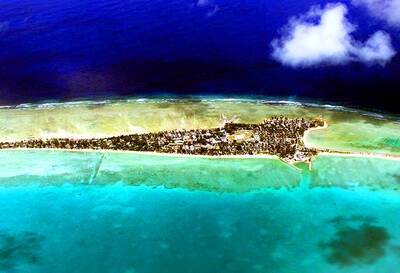In a troubling reversal, the US teen birth rate rose for the first time in 15 years, surprising government health officials and reviving the bitter debate about abstinence-only sex education.
The birth rate had been dropping since its peak in 1991, although the decline had slowed in recent years. On Wednesday, government statisticians said it rose 3 percent from 2005 to last year.
The reason for the increase is not clear, and federal health officials said it might be a one-year statistical blip, not the beginning of a new upward trend.
However, some experts said they have been expecting a jump. They blamed it on increased federal funding for abstinence-only health education that does not teach teens how to use condoms and other contraception.
Some key sexually transmitted disease rates have been rising, including syphilis, gonorrhea and chlamydia. The rising teen pregnancy rate is part of the same phenomenon, said Carol Hogue, an Emory University professor of maternal and child health.
"It's not rocket science," she said.
At the same time, some research suggests teens are using condoms far more often than they did 15 years ago.
The new teen birth numbers are based on the 15 to 19 age group of women, which accounted for most of the 440,000 births to teens last year. The rate rose to nearly 42 births per 1,000 in that group, up from 40.5 in 2005. That translates to an extra 20,000 births to teen mothers.
In 1991, the peak year for teen births, there were nearly 62 births per 1,000.
The new report is based on a review of more than 99 percent of the birth certificates from last year by the US Centers for Disease Control and Prevention.
The report, released on Wednesday, quickly took on political implications.
Opponents of abstinence-based programs seized on the data as evidence of wrong-headed government policy.
"Congress needs to stop knee-jerk approving abstinence-only funding when it's clear it's not working," said Democratic US Representative Diana DeGette, who is pushing for more comprehensive sex education.
The new report offers a state-by-state breakdown of birth rates overall. Many of those with the highest birth rates teach abstinence instead of comprehensive sex education, according to the Planned Parenthood Federation of America.
And research has concluded that abstinence-only programs do not cause a decrease in teenage sexual activity, Planned Parenthood officials said.
"In the last decade, more than US$1 billion has been wasted on abstinence-only programs," said Cecile Richards, the organization's president, in a prepared statement.
Decreased condom use and increased sexual activity are two likely explanations for the higher teen birth rate. But not all data supports those theories, said John Santelli, a professor of population and family health at Columbia University's school of public health.
For example, a biannual government survey of high school students found that the percentage of those who said they used a condom the last time they had sex rose to 63 percent in 2005, up from 46 percent in 1991.
Contraceptive-focused sex education is still common, and the new teen birth numbers reflect it is failing, argued Moira Gaul of the Family Research Council, a conservative advocacy organization in Washington.
The CDC also reported that births to unwed mothers reached an all-time high last year, but that is part of a continuing upward trend and was expected.
Health officials cautioned that the rise in teen births is not the chief cause of births to unwed mothers, however.

DISASTER: The Bangladesh Meteorological Department recorded a magnitude 5.7 and tremors reached as far as Kolkata, India, more than 300km away from the epicenter A powerful earthquake struck Bangladesh yesterday outside the crowded capital, Dhaka, killing at least five people and injuring about a hundred, the government said. The magnitude 5.5 quake struck at 10:38am near Narsingdi, Bangladesh, about 33km from Dhaka, the US Geological Survey (USGS) said. The earthquake sparked fear and chaos with many in the Muslim-majority nation of 170 million people at home on their day off. AFP reporters in Dhaka said they saw people weeping in the streets while others appeared shocked. Bangladesh Interim Leader Muhammad Yunus expressed his “deep shock and sorrow over the news of casualties in various districts.” At least five people,

It is one of the world’s most famous unsolved codes whose answer could sell for a fortune — but two US friends say they have already found the secret hidden by Kryptos. The S-shaped copper sculpture has baffled cryptography enthusiasts since its 1990 installation on the grounds of the CIA headquarters in Virginia, with three of its four messages deciphered so far. Yet K4, the final passage, has kept codebreakers scratching their heads. Sculptor Jim Sanborn, 80, has been so overwhelmed by guesses that he started charging US$50 for each response. Sanborn in August announced he would auction the 97-character solution to K4

SHOW OF FORCE: The US has held nine multilateral drills near Guam in the past four months, which Australia said was important to deter coercion in the region Five Chinese research vessels, including ships used for space and missile tracking and underwater mapping, were active in the northwest Pacific last month, as the US stepped up military exercises, data compiled by a Guam-based group shows. Rapid militarization in the northern Pacific gets insufficient attention, the Pacific Center for Island Security said, adding that it makes island populations a potential target in any great-power conflict. “If you look at the number of US and bilateral and multilateral exercises, there is a lot of activity,” Leland Bettis, the director of the group that seeks to flag regional security risks, said in an

ON THE LAM: The Brazilian Supreme Court said that the former president tried to burn his ankle monitor off as part of an attempt to orchestrate his escape from Brazil Former Brazilian president Jair Bolsonaro — under house arrest while he appeals a conviction for a foiled coup attempt — was taken into custody on Saturday after the Brazilian Supreme Court deemed him a high flight risk. The court said the far-right firebrand — who was sentenced to 27 years in prison over a scheme to stop Brazilian President Luiz Inacio Lula da Silva from taking office after the 2022 elections — had attempted to disable his ankle monitor to flee. Supreme Court judge Alexandre de Moraes said Bolsonaro’s detention was a preventive measure as final appeals play out. In a video made